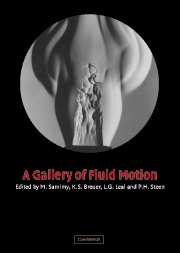7 - Free surface interaction
Published online by Cambridge University Press: 25 January 2010
Summary
Laminar jets can splash!
It has been observed that a liquid jet impinging on a solid surface can produce splashing. High-speed photography has revealed that, with a turbulent jet, splashing is related to the jet surface roughness. To investigate the importance of the jet shape on splashing, perturbations of known frequency or amplitude are imposed on the surface of a smooth laminar jet.
The top picture shows the unperturbed smooth jet as it spreads radially on the solid surface. The varicose deformations imposed on the jet surface alter the flow quite dramatically (center picture). As we further increase the amplitude of the oscillations, splashing starts suddenly. The bottom picture shows the beauty and complexity of splashing.
Impacting water drops
The four photographs shown here are representative of a series which recorded the structure and evolution of the vorticity generated by a water drop impacting a free surface of water in a container. The 2.8 mm diam water drop was dyed with fluorescein and released from the tip of a hypodermic needle under specific parameters, We=26, Fr=25. The Weber number (ρU2d /γ) and Froude number (U2/gd) are based on drop diameter d, impact velocity U, and surface tension γ.
Figure 1 is photographed from the side and slightly below the free surface while Fig. 2 is shot looking directly up at the free surface via a mirror. These alternative viewing angles provide a valuable tool in visualizing the threedimensional flow structure. A “primary” vortex ring can be seen convecting away from the free surface. A convoluted secondary structure can be seen wrapped around the primary core.
- Type
- Chapter
- Information
- A Gallery of Fluid Motion , pp. 72 - 80Publisher: Cambridge University PressPrint publication year: 2004



